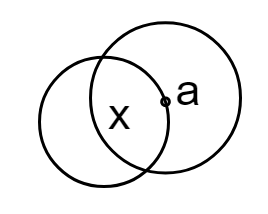
What is the axis of rotation of a purely rotating body?
A. Must pass through the center of mass
B. May pass through the center of mass
C. Must pass through the particle of the body
D. May pass through the particle of the body
Answer
218.1k+ views
Hint: It is important to know about the axis of rotation and center of mass. The point or axis around which the object rotates is known as the axis of rotation. If you consider a point in a body or system of bodies at which the whole mass is concentrated at the center of the body known as the center of mass. Now let’s find the answer to the question given.
Complete step by step solution:
A body is said to be in the pure rotation when it rotates about a certain fixed axis and this axis could be anywhere. It is not necessary that it must pass through the center of mass or through some particle or a body. It can also be outside the body. Purely rotating means if a body is in pure rotation, then each point of the body must go in a circle. To understand this, consider an example.
Take a disc ‘a’ and the axis of rotation ‘x’ doesn’t pass through the center of mass.

Image: Disc
Here we can see that point ‘a’ rotates purely in a circle. Hence, the axis of rotation may pass through the center of mass.
Now, if the axis of rotation passes through the center of the mass, then points also rotate in a circle. Hence, the axis of rotation may pass through the particle of the body. Therefore, the axis of rotation of a purely rotating body may pass through the center of mass and also through the particle of the body.
Hence, Option B and D both are the correct answer.
Note: If the axis passes through the body’s center of mass, the body is said to rotate upon itself or spin. Objects that cannot rotate or spin completely can nonetheless be thought to be revolving around an axis. Ankles and knees, as well as mechanical pieces and a variety of other things, may rotate in a restricted circle around an internal line.
Complete step by step solution:
A body is said to be in the pure rotation when it rotates about a certain fixed axis and this axis could be anywhere. It is not necessary that it must pass through the center of mass or through some particle or a body. It can also be outside the body. Purely rotating means if a body is in pure rotation, then each point of the body must go in a circle. To understand this, consider an example.
Take a disc ‘a’ and the axis of rotation ‘x’ doesn’t pass through the center of mass.

Image: Disc
Here we can see that point ‘a’ rotates purely in a circle. Hence, the axis of rotation may pass through the center of mass.
Now, if the axis of rotation passes through the center of the mass, then points also rotate in a circle. Hence, the axis of rotation may pass through the particle of the body. Therefore, the axis of rotation of a purely rotating body may pass through the center of mass and also through the particle of the body.
Hence, Option B and D both are the correct answer.
Note: If the axis passes through the body’s center of mass, the body is said to rotate upon itself or spin. Objects that cannot rotate or spin completely can nonetheless be thought to be revolving around an axis. Ankles and knees, as well as mechanical pieces and a variety of other things, may rotate in a restricted circle around an internal line.
Recently Updated Pages
Arithmetic, Geometric & Harmonic Progressions Explained

Cartesian Form of Vector Explained: Formula, Examples & Uses

Apparent Frequency Explained: Formula, Uses & Examples

Calorimetry: Definition, Principles & Calculations

Centrifugal Force Explained: Definition, Formula & Examples

Charge in a Magnetic Field: Definition, Formula & Examples

Trending doubts
Understanding Collisions: Types and Examples for Students

Ideal and Non-Ideal Solutions Explained for Class 12 Chemistry

Degree of Dissociation: Meaning, Formula, Calculation & Uses

Understanding Elastic Collisions in Two Dimensions

A particle moves in a straight line according to the class 11 physics JEE_MAIN

Understanding Newton’s Laws of Motion

Other Pages
Gravitation Class 11 Physics Chapter 7 CBSE Notes - 2025-26

NCERT Solutions For Class 11 Physics Chapter 13 Oscillations - 2025-26

Motion In A Plane Class 11 Physics Chapter 3 CBSE Notes - 2025-26

Mechanical Properties of Fluids Class 11 Physics Chapter 9 CBSE Notes - 2025-26

NCERT Solutions For Class 11 Physics Chapter 12 Kinetic Theory - 2025-26

Inertial and Non-Inertial Frame of Reference Explained




